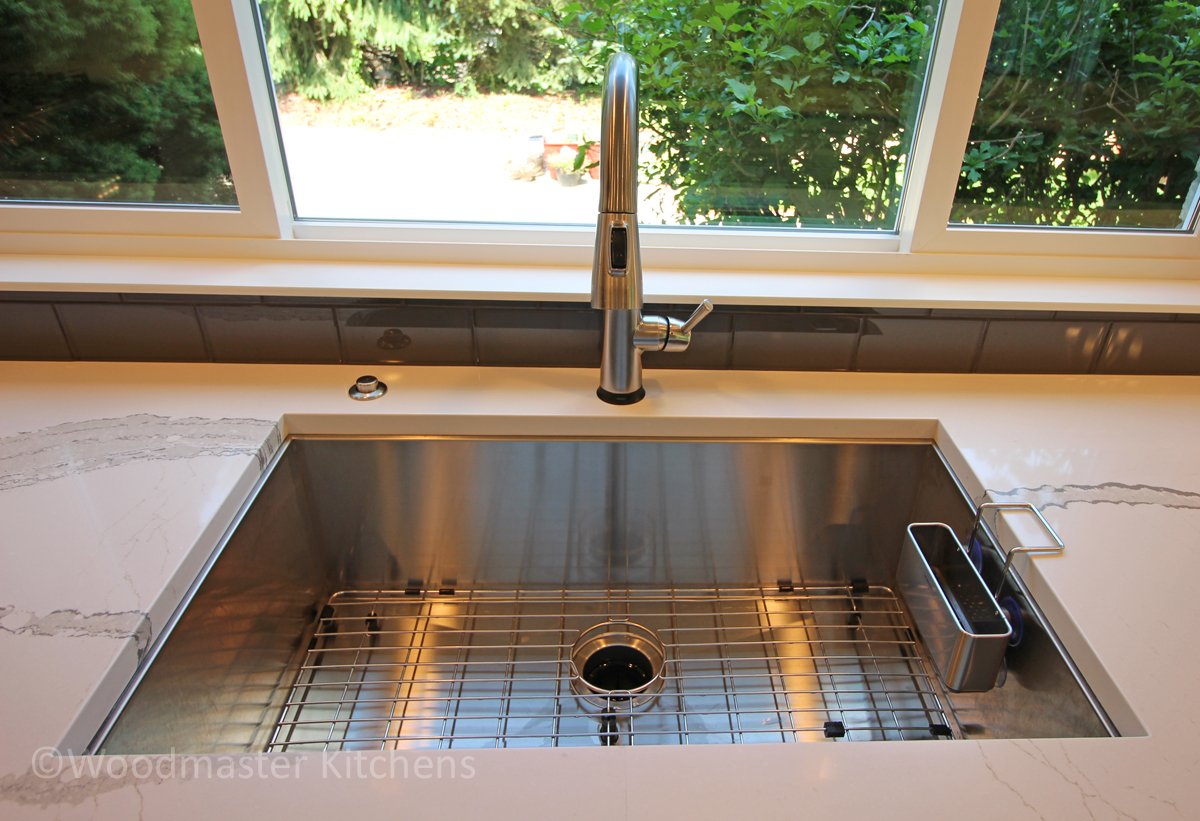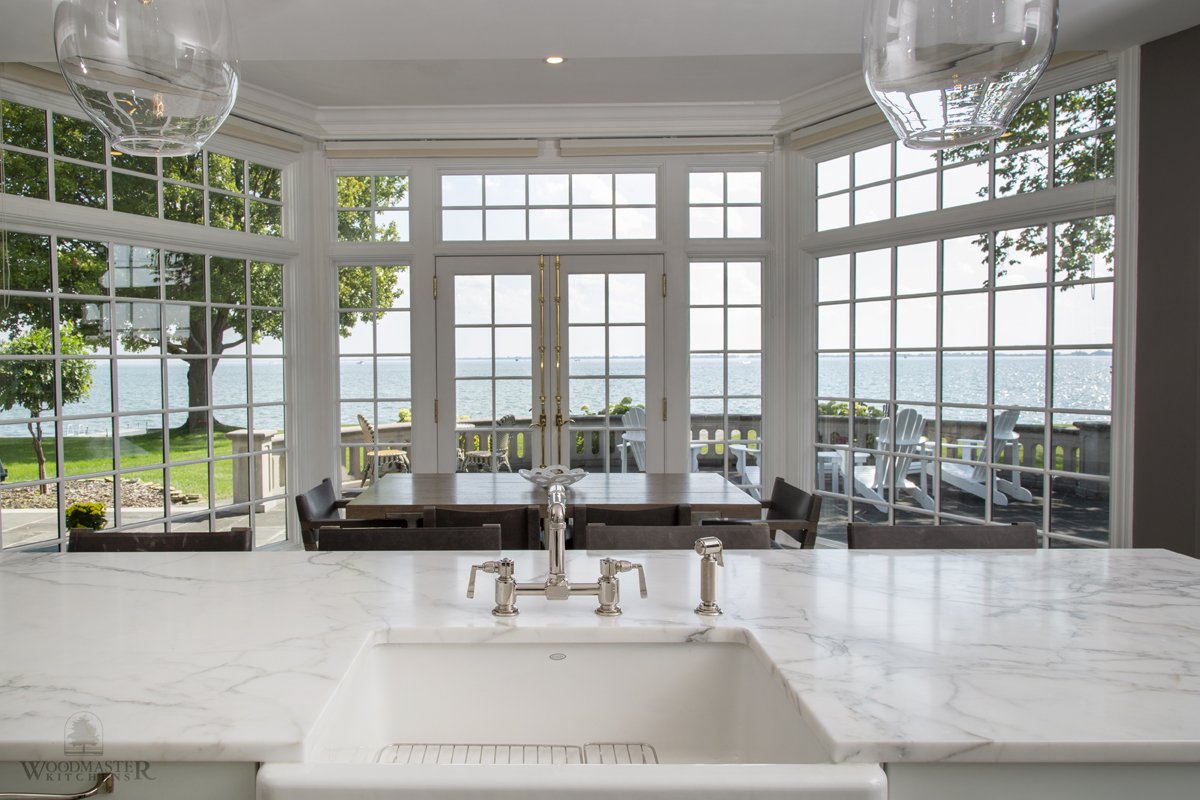Find the Perfect Kitchen Sink and Faucet Combinations
Your sink and faucet are a crucial, functional part of your kitchen remodel but also a focal point of your entire design. They are part of cooking and cleaning and essential for sanitization. One of the easiest ways to upgrade an existing kitchen design is to change your sink and faucet.
As they are in the center of your design, they can transform the whole space, complementing the style of your kitchen remodel. Choosing the right combination means you are further enhancing your kitchen design’s functionality and style. Here are our tips for finding the perfect kitchen sink and faucet combination.
What Factors Do You Need to Consider?
Before you look at any sinks or faucets it is important to establish your requirements. Your budget, style preference, and lifestyle should be taken into consideration when making product selections for a kitchen remodel. Also, how large is your kitchen design and what is the layout? Consider the style and finishes throughout your design and decide if your sink and faucet need to match, for a uniform look.
Think about who will be using the new kitchen design. Is it a household with more than one generation? Should you consider universal design in your sink and faucet, so they are easier to use? Would you make use of more than one sink in your kitchen design, and do you have the space for this? You might want a sink in a prep or clean up area. A main sink could make a statement and do most of the work and then a beverage bar can have a smaller, but hard-working sink and faucet combination.
Types of Sinks
There is a sink for every style and budget. How often will you be using the sink and for what purpose? Determine the size, type, and location to fit in with your existing plumbing, or factor in additional costs if you plan to change your plumbing configuration.
How your countertop is constructed, and the material of your sink make a difference to how your sink is installed and how it functions. There are several types of kitchen sinks:
A Drop-in sink (also called a Top Mount) drops into a hole in the countertop. The edge just rests on the counter and it can be installed or replaced easily.
An Undermount sink is installed under the counter and works well with granite, quartz, or solid surface countertops. It is also easier to clean this type of sink as there is no edge on top of the countertop to clean around.
A farmhouse sink is exposed at the front and is typically wide and deep. It is great for washing larger items but needs a specific base cabinet to support it.
Wall-mounted sinks don’t need a cabinet and free up floor space. They are a good choice for a home that needs accessibility as they can be installed at wheelchair height.
Bar sinks are ideal as second sinks as they are smaller and can easily fit into an island or beverage bar.
Workstation sinks like The Galley Workstation are perfect for busy kitchens as they transform into a prep space, clean up zone, and even a serving station. They include custom features such as cutting boards, colanders, and serving containers that slide in and out easily when you need them.
Sink Materials
How you use your kitchen sink influences your choice of materials. A high-maintenance surface might not fit into a busy lifestyle. A family that cooks and bakes a lot would need a deep and durable basin. It is equally as important to choose a sink material that complements your kitchen design’s overall style.
Stainless steel is the most popular sink material and comes in many styles. The higher the quality, the more scratch resistant it is. Brushed finishes also hide scratches and water spots.
Copper sinks are very low maintenance and have an anti-bacterial quality. They are durable and uniquely crafted and look even better with age.
Granite/Quartz Composite sinks are scratch, stain, and heat resistant and come in drop-in, farmhouse and undermount styles and a range of colors.
Fireclay is used mainly in farmhouse style sinks and resembles cast iron. It is a hard-fired clay that resists scratches, chips, and acid and comes in many colors, with white being the most popular.
Cast iron sinks are coated in porcelain enamel so are quite easy to clean. They are exceptionally durable but very heavy, so should not be wall mounted.
Sink Configuration
You need to work out the orientation, bowls, and number of holes you’ll need in your new sink. For example, the sink should be to the left of your dishwasher and garbage disposal, if you are right-handed.
An angular sink is generally deeper, but a rounded shape is easier to clean. If you are installing a sink on an existing kitchen cabinet, make sure that it fits correctly. Single bowl sinks can be large while double bowls can have two equal sized bowls or different sizes for performing different tasks. Triple bowl sinks have a small third bowl for food prep.
A sink can have up to six holes for different types of hardware, but if you’re using fewer holes, you can cover the others with deck plates. Conversely, you can drill extra holes in a lighter material sink if required, or in a counter before it is installed.
Types of Faucets
Explore the different styles, features and finishes of faucets before you make a choice. You might want a faucet to pick up on certain styles or colors in your kitchen design, such as hardware and lighting, and it’s important to take your sink and countertop style into consideration too. There are many types of faucets available, including:
Deck-mounted faucets can be installed on the kitchen sink edge or countertop and make a design focus of your sink. They are the most popular style and come in a huge variety of options.
Wall-mounted faucets are perfect for modern or industrial style kitchen designs and are great for freeing up counter space.
High arc (or gooseneck) faucets are elegantly arced and ideal for filling large vessels.
Pull-down and pull-out faucets let you extend and retract the spouts for greater control and, when paired with a sprayer function, make cleaning up much easier.
Bridge faucets are double handled models that work well in a traditional style kitchen design, embracing classic curved surfaces.
Increasing smart technology means voice-activated faucets are available.
Also, filtered, boiling, and carbonated water can come from dedicated faucets for the ultimate in convenience and luxury.
From traditional to modern, faucets also come in a wide range of styles depending on the lines of the faucet, the finish, and any extra detailing on the faucet and handles. Transitional style faucets are a popular choice, as they offer a mix of traditional and modern, keeping it current with old school details. Craftsman and farmhouse faucets styles lean towards traditional looks with rich, vintage finishes. Contemporary faucets are sleek with clean lines. Industrial style focuses on exposed mechanisms such as wheels, springs, or cross handles.
Faucet Materials
There are many quality materials and finishes for faucets, each with its own benefits and price tag. Faucets were traditionally made of metal inside and out, which meant that lead was released into the water. This has now changed, leading manufacturers to produce lead free products. Review the options with your kitchen design professional and make sure your faucet choice is as lead free as possible.
Your faucet’s finish influences both your style and the long-term maintenance as some materials are easier to keep clean than others.
Chrome is an ever-popular finish as it is durable and versatile, but it does tend to show up fingerprints and water spots.
Brushed nickel is ideal for resisting them, so may be an alternative in a busy kitchen (especially a home with kids).
Oil rubbed bronze, rose gold, and matte black are other finishes that have gained popularity recently. Each complements a particular style of kitchen design, so you may not want to choose these more distinctive finishes if you plan to sell your home in the near future.
Stainless steel is very durable and stylish, and while it tends to show water marks, a brushed finish can help to resist marks.
Satin, matte and polished are other textures that amp up your faucet style. Most materials are available in a range of finishes, so select the one that best fits your style and practical needs.
Faucet Configuration
The faucet you choose should fit the number of holes you have in your sink. Consider other fixtures that need holes, such as soap dispensers or separate pull-down sprayers. For example, an integrated single handle faucet needs one hole but a faucet with a separate handle, or side spray, takes up two holes. A two-handle faucet requires three holes, with separate controls for hot and cold water. A Bridge faucet can require up to four holes, with a center water flow pipe, temperature handles, and a separate side spray. Consider which valve would work for your faucet also. A ball, disk, cartridge, or compression valve are the four main types that affect performance and maintenance. Your kitchen design expert should guide you in this choice. The faucet you choose depends on the functionality you desire, but also the style of your kitchen design.
Creating the Perfect Combination
How do you ensure that the kitchen faucet and sink you have chosen will work well together? Apart from making sure the sink holes correspond to the faucet, you need to ensure your faucet height and arc are correct to match your kitchen design’s space and layout.
Here are a few key points to consider when selecting a faucet installation style:
If you have chosen a high arc spout, make sure that it doesn’t brush off an upper cabinet.
Also check that the faucet is positioned for water to hit the center of your sink without splashing.
The space between the sink and wall needs to be accounted for when calculating the position of a wall mounted spout.
For a deck mounted faucet, there needs to be enough installation room behind the sink.
Consider your family’s requirements and choose a faucet and sink combination accordingly. For example, a lower sink or touchless faucet might be the answer for children or mobility impaired family members.
Also consider your design aesthetic when selecting a faucet and sink combination. You can choose to match your sink and faucet styles and finishes or mix them up for an eclectic vibe. They should both pick up on a common theme in your kitchen design though, to avoid looking mismatched. A sure way of getting the right combination is to choose a Galley Workstation sink and Galley Tap with a range that complement each other beautifully.
Coordinate your faucet and sink finish with other kitchen fixtures and appliances for a kitchen remodel that is really pulled together. At Woodmaster Kitchens, our kitchen design experts can help you every step of the way and show you what combinations could work for your remodel. We are also the area’s authorized dealer for the revolutionary Galley Workstation, which is the perfect blend of style and functionality for a modern luxury kitchen. Talk to us today about your kitchen remodel, including the ideal sinks and faucets for your kitchen design.









